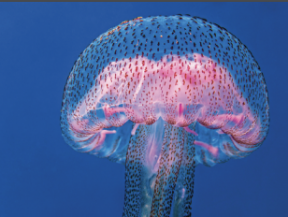Beware of jellyfish this summer
Jellyfish are marine creatures that call the saltwater of the Chesapeake Bay home during several months of the year.
 Many jellyfish stings are painful but not harmful, like those in the Chesapeake Bay. Still, certain regions of the world are home to dangerous jellies.
Many jellyfish stings are painful but not harmful, like those in the Chesapeake Bay. Still, certain regions of the world are home to dangerous jellies.
Summer often includes a few jaunts to the beach to cool off and enjoy some swimming and sunbathing. For those who have the benefit of living close to an ocean, few things beat the allure and majesty of a pristine coastline. A day at the beach can be spent surfing the waves, collecting seashells or relaxing with toes in the sand.
The world’s oceans are diverse ecosystems that are home to many creatures large and small. When beach-goers enter the water, they should understand that they may be sharing the sea with crabs, fish and even mammals. Some sea creatures are relatively harmless, while others can be more dangerous in certain situations. Understanding the differences can keep both marine life and people safe.
Jellyfish are marine creatures that call the saltwater home in various areas and during different months of the year. There are more than 200 species of jellyfish, which come in a diverse range of forms. Jellyfish can be found in every ocean in the world, and some can thrive in freshwater lakes and ponds as well.
The jellyfish’s main defense mechanisms are its stings and its transparent body, which make it hard to see in the water. Jellyfish have the potential to sting, and some dangerous varieties can even cause death. Beach-goers’ best defense is to learn about jellyfish, including how to recognize those that pose a threat to human health.
The sea wasp of coastal Australia and Indo-Pacific regions; the chiropsalmus quadrigatus of the same region; the tiny irukandji, which has spread to many different waters; and the alatinaalata, found in both Pacific and Atlantic waters, are some of the world’s most dangerous jellyfish, says Smithsonian. Most of these jellies are box jellyfish, which get their name from the cube-shaped swimming bell. Stings can be extremely painful, and some are fatal to humans, although there are some antivenoms available in Australia, where many encounters with this type of jellyfish occur.
Many people will never encounter a deadly variety of jellyfish. However, jellyfish populations generally are on the rise, and that figures to lead to an increase in stings as well. In 2018, more than 1,000 people were stung on a Florida beach in one week. The National Marine Fisheries Service says there have been more blooms of jellyfish in different parts of the world. Agricultural runoff, commercial fishing and warmer oceans have contributed to the increased jellyfish population in recent years.
Most jellyfish stings occur in the summer and fall when people are most active at the beach. Jellyfish stings can be treated with vinegar to neutralize the pain before removing the tentacles if they are present. Also, exercise caution when walking barefoot on the beach, as there may be jellyfish washed up on the sand.

